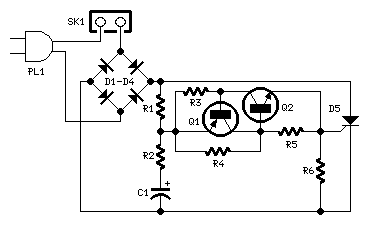220 Volts Flashing Lamps
Especially designed for Christmas tree lamps
Replaces old thermally-activated switches

Parts:
R1___________100K 1/4W Resistor
R2,R5__________1K 1/4W Resistors
R3,R6________470R 1/4W Resistors
R4____________12K 1/4W Resistor
C1__________1000µF 25V Electrolytic Capacitor
D1-D4_______1N4007 1000V 1A Diodes
D5__________P0102D 400V 800mA SCR
Q1___________BC327 45V 800mA PNP Transistor
Q2___________BC337 45V 800mA NPN Transistor
PL1__________Male Mains plug
SK1__________Female Mains socket
Device purpose:
This circuit is intended as a reliable replacement to thermally-activated
switches used for Christmas tree lamp-flashing. The device formed by Q1, Q2 and
related resistors triggers the SCR. Timing is provided by R1,R2 & C1. To change
flashing frequency don't modify R1 and R2 values: set C1 value from 100 to
2200µF instead.
Best performances are obtained with C1=470 or 1000µF and R4=12K or 10K. Due to
low consumption of normal 10 or 20 lamp series-loops intended for Christmas
trees (60mA @ 220V typical for a 20 lamp series-loop), very small and cheap SCR
devices can be used, e.g. C106D1 (400V 3.2A) or TICP106D (400V 2A), this last
and the suggested P0102D devices having TO92 case.
Important Note:
For proper operation it's absolutely necessary to employ high Gate-sensitive
SCRs.
If you are unable to find these devices you can use Triacs instead. In this case
the circuit operates also with relatively powerful devices. A recommended Triac
type is the ubiquitous TIC206M (600V 4A) but many others can work.
Note that in spite of the Triac, diode bridge D1-D4 is in any case necessary.
This circuit was awarded with publication in ELECTRONICS WORLD "Circuit Ideas",
June 2000 issue, page 458.
Title: 220 Volts Flashing Lamps
electronic circuit
Source: www.redcircuits.com
Published on: 2005-02-03
Reads: 1602
Print version: ![]()
Other electronic circuits and schematics from Motor, light and power control
-
Flashy Christmas Lights
-
12 Volt Lamp Dimmer
-
DC Motor Control Circuit
-
LED Photo Sensor
-
12VDC Fluorescent Lamp Driver
-
16 Stage Bi-Directional LED Sequencer
-
Simple DC motor PWN speed control
-
Automatic Dual output Display
-
Dancing LEDs
-
Automatic Speed Controller for fans & Coolers
